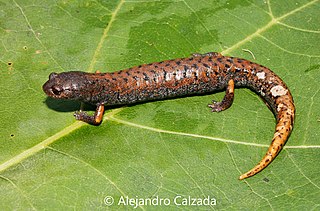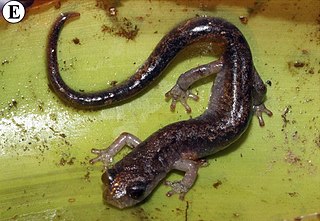Cortes salamander is a species of salamander in the family Plethodontidae. It is found in the Sierra de Omoa in northwestern Honduras and Sierra de Caral in eastern Guatemala, close to the border with Honduras. The vernacular name Cortes salamander refers to the Cortés Department where the type locality is located, whereas the alternative name Cortez' hidden salamander with the spelling "Cortez" and the apostrophe are errors.
Pseudoeurycea lineola, commonly known as the Veracruz worm salamander or Mexican slender salamander, is a species of salamander in the family Plethodontidae. It is endemic to the eastern slope of the Trans-Mexican Volcanic Belt near Cuautlapan, in the west-central Veracruz, Mexico, at elevations of 800–1,250 m (2,620–4,100 ft) above sea level. Molecular evidence suggests that it consists of two distinct species. It was the type species of genus Lineatriton.
Pseudoeurycea orchimelas, commonly known as the San Martin worm salamander, is a species of salamander in the family Plethodontidae. It is endemic to Veracruz, Mexico, where it is known from the Sierra de los Tuxtlas at elevations of 100–1,300 m (330–4,270 ft) above sea level.

Parvimolge is a genus of salamanders in the family Plethodontidae, the lungless salamanders. It is currently considered as monotypic, although this may yet change as molecular data suggest that it is embedded within a paraphyletic Pseudoeurycea. Parvimolge townsendi is endemic to the northern Sierra Madre de Oaxaca in central and southern Veracruz, Mexico, between 900 and 1900 meters elevation. It is represented by the species Parvimolge townsendi, commonly known as Townsend's dwarf salamander.

Pseudoeurycea is a genus of salamander in the family Plethodontidae. The members of this genus are commonly known as the false brook salamanders. They are found in Mexico and Guatemala.

Pseudoeurycea aurantia, commonly known as Peña Verde salamander, is a species of salamander in the family Plethodontidae. It is endemic to Oaxaca, Mexico and only known from its type locality near Peña Verde, which is the northernmost high peak in the Sierra de Juárez.
The southern giant salamander is a species of salamander in the family Plethodontidae. It is endemic to Mexico and known from the Sierra Madre del Sur of western and southern Oaxaca and eastern Guerrero. It is the largest tropical salamander; the holotype had a total length of about 24 cm (9.4 in) and weighed 58 grams (2.0 oz).
Pseudoeurycea melanomolga, commonly known as the black false brook salamander or black salamander, is a species of salamander in the family Plethodontidae. It is endemic to Mexico and known from the surroundings of the Cofre de Perote in west-central Veracruz as well as from two localities in the adjacent northeast Puebla.
Isthmura naucampatepetl, commonly known as the Cofre de Perote salamander, is a species of salamanders in the family Plethodontidae. It is endemic to the Sierra Madre Oriental in central Veracruz, Mexico, where it is known from between Cofre de Perote and Cerro Volcancillo, a satellite peak of Cofre de Perote.
Pseudoeurycea nigromaculata, commonly known as the black-spotted salamander or black-spotted false brook salamander is a species of salamander in the family Plethodontidae. It is endemic to Veracruz, Mexico, and known from Cerro Chicahuaxtla ) in Cuatlalpan and from Volcán San Martín at elevations of 1,200–1,300 m (3,900–4,300 ft). These separate populations likely represent distinct species.
The ridge tail salamander, also known as ridge-tailed salamander is a species of salamander in the family Plethodontidae. It is endemic to Oaxaca, Mexico, and only known from the area of its type locality on the mountain pass of Plan de Guadalupe in the Sierra de Mazateca, part of the Sierra Madre de Oaxaca, at 2,150 meters elevation. Future work might prove it to be more widespread than current records suggest. Its extent of occurrence is 10 km2.
The Cuetzalan salamander is a species of salamander in the family Plethodontidae. It is endemic to the Sierra Madre Oriental in Puebla, Mexico. Its specific name refers to its type locality, Cuetzalan del Progreso. Its natural habitat is cloud forest, but it also occurs in coffee groves. It has been found in a range of micro-habitats, such as under moss in rock walls, under stones, inside and under rotten logs, and in leaf axils. It might be threatened by habitat loss caused by human settlements and tourist development.
Pseudoeurycea robertsi is a species of salamander in the family Plethodontidae. It is endemic to Mexico and only known from the Nevado de Toluca, near Toluca in the State of Mexico. Its common name is Roberts' false brook salamander. The specific name robertsi honors the collector of the holotype, H. Radclyffe Roberts from the Philadelphia Academy of Sciences.

Pseudoeurycea ruficauda, also known as the orange-tailed agile salamander, is a species of salamander in the family Plethodontidae. It is endemic to the Sierra Mazateca, a part of Sierra Madre de Oaxaca of Mexico. The specific name ruficauda derives from the Latin words rufous (=reddish) and cauda (=tail) and refers to the reddish orange tail of this salamander. P. jaguar is its closest relative.
Pseudoeurycea smithi, commonly known as Smith's false brook salamander, is a species of salamander in the family Plethodontidae. It is endemic to certain mountainous regions of Mexico. Its natural habitat is subtropical or tropical moist montane forests. It is threatened by habitat loss.
Pseudoeurycea teotepec, commonly known as the Teotepec salamander, is a species of salamander in the family Plethodontidae. It is endemic to Mexico and only known from its type locality, southern slope of Cerro Teotepec in Guerrero, at about 3,425 m (11,237 ft) asl.
Pseudoeurycea unguidentis is a species of salamander in the family Plethodontidae. It is endemic to northern Oaxaca, Mexico, where it is known from its type locality, Cerro San Felipe in the Sierra Madre de Oaxaca, and some other mountains, although the identity of animals from these other locations is uncertain. Its common names are claw-toothed salamander, clawtooth false brook salamander, and clawtoed false brook salamander.
Thorius arboreus, commonly known as the arboreal minute salamander, is a species of salamander in the family Plethodontidae. It is endemic to Sierra de Juarez, Oaxaca, Mexico. The specific name arboreus, derives from the Latin word arbor, meaning tree, referring to the arboreal habitat of this species.
Thorius, also known as minute salamanders, pigmy salamanders, or Mexican pigmy salamanders, is a genus of salamanders in the family Plethodontidae. They are endemic to Mexico and found in southern Veracruz and Puebla to Guerrero and Oaxaca.

Isthmura is a genus of salamanders in the family Plethodontidae. They are endemic to Mexico. The genus, which corresponds to the former "Pseudoeurycea bellii species group" and was first described as a subgenus of Pseudoeurycea, was raised to full generic level in 2015 in order to preserve Ixalotriton and Bolitoglossa while avoiding paraphyly of Pseudoeurycea.






